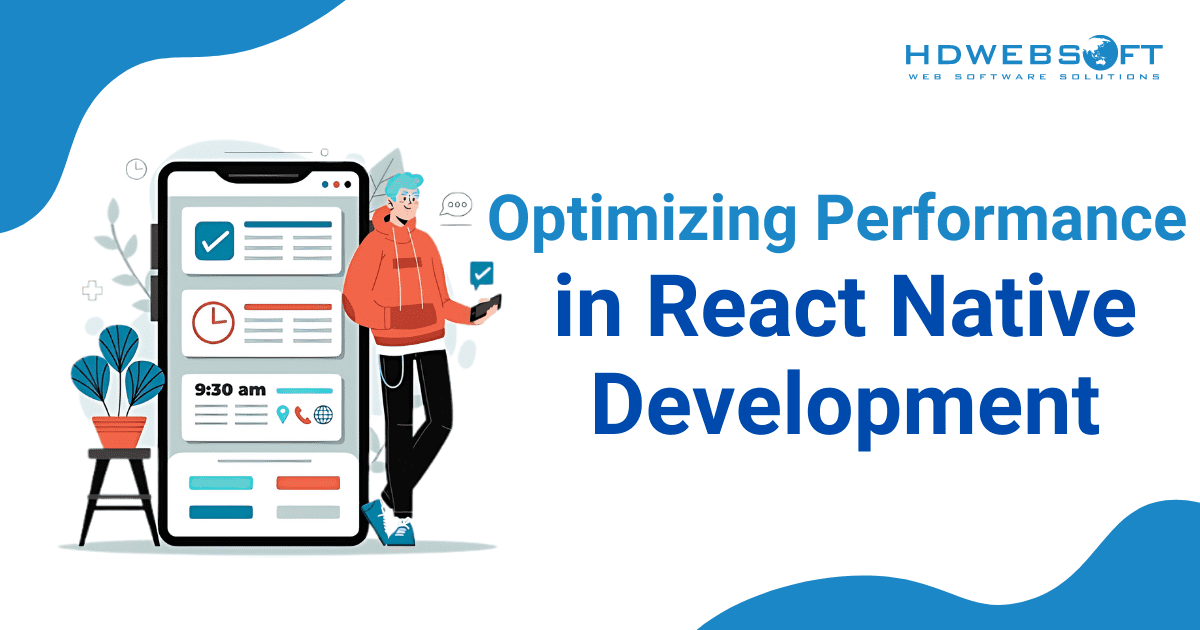
React Native or Native App for Mobile Application Development
Today, over 4 million apps are available across iOS and Android platforms, extending to a wide range of sub-genres and niches. For such competition, choosing the right approach is crucial. Two popular options for developing a mobile app are React Native and native app development.
While native apps are developed specifically for iOS or Android using languages like Swift or Kotlin, React Native allows for building apps using a single codebase that works across both platforms.
This blog explores the pros and cons of both approaches, assisting you in making informed decisions about your next project.
What is a Native App?

A native app is developed specifically for one platform—either iOS or Android—using platform-specific programming languages and tools. For iOS, this typically involves using Swift or Objective-C and Xcode, while for Android, it involves Kotlin or Java and Android Studio.
Native apps are designed to leverage the full capabilities of the device’s operating system and hardware, offering a high level of performance and user experience.
The Pros and Cons of React Native

React Native offers a tempting middle ground between native app development and web development. While it boasts faster development times and code reusability, it might have limitations in terms of achieving the most platform-specific features and top-tier performance.
Pros of React Native
Cross-Platform Development
One of React Native’s biggest advantages is cross-platform development. You can write a single codebase that works for both iOS and Android apps, significantly cutting down on development time and costs. There is no need to maintain separate codebases for each platform, saving resources and streamlining the process.
Faster Development
React Native development is further streamlined by its hot reloading feature. As you make changes to your code, you can see those adjustments reflected in the app instantly, without the need for lengthy recompile cycles. This allows for faster iteration and a more efficient development workflow.
Community Support
React Native is backed by a large and active developer community. This translates to a vast array of readily available libraries and plugins. You can find solutions for common problems and add functionalities to your app without reinventing the wheel. This not only saves development time but also ensures you’re incorporating well-tested and maintained code.
Cost Efficiency
By developing a single app that supports both iOS and Android, React Native promotes cost-efficiency. Compared to building separate native apps, you’ll need fewer resources overall. This translates to lower development costs, making it an attractive option for businesses of all sizes.
Cons of React Native
Performance Issues
React Native excels in performance for many applications. However, tasks demanding high CPU usage might not quite reach the level of fully native apps. This is because native apps have direct access to the device’s hardware, whereas React Native bridges the gap with JavaScript, potentially introducing a slight performance overhead.
Read more about How to Optimize Performance Using React Native.
Limited Access to Native APIs
While React Native provides a comprehensive suite of native functionalities, there can be situations where you require highly specific or cutting-edge APIs. In these cases, you might need to develop custom native modules to bridge the gap. This can add complexity to the development process, requiring additional expertise in native development languages like Java, Kotlin, or Swift.
UI/UX Limitations
While React Native provides a high degree of flexibility, it may not always be able to fully exploit all the platform’s unique UI/UX features and animations. This could potentially lead to a slightly less polished user experience compared to a fully native app.
The Pros and Cons of Native App

Native app development offers the ultimate control and performance for your mobile app. Built specifically for each platform with their unique languages, native apps can leverage all the features and functionalities of the device. This translates to a potentially faster, more responsive user experience, but it comes at the cost of longer development times and separate codebases for each platform.
Pros of Native App Development
Superior Performance
Native apps are built specifically for each platform, allowing them to take full advantage of the underlying hardware. This translates to lightning-fast responsiveness and smooth performance, critical for demanding applications like games or those with complex graphics.
Full Access to Device Features
Native development grants unrestricted access to a device’s entire toolkit of features and APIs. This allows for richer functionalities and seamless integrations with features like the camera, microphone, or GPS, creating a more robust and versatile app.
Enhanced User Experience
Because native apps are built using the same tools and design languages as the platform itself, they inherit a familiar look and feel. This translates to an intuitive and polished user experience that feels like a natural extension of the device itself.
Cons of Native App Development
Higher Development Costs
Building separate native apps for a certain operation system requires a significant investment in time and resources. You’ll need two separate development teams or developers with expertise in both platforms, leading to potentially higher overall costs.
Longer Development Time
Maintaining two separate codebases, one for iOS and one for Android, translates to longer development cycles for new features and updates. Bug fixes and improvements need to be implemented and tested on both platforms, extending the overall timeline.
Resource Intensive
Native app development demands developers with specialized knowledge in platform-specific languages like Swift for iOS and Kotlin for Android. This can be challenging and expensive, as these skill sets are less common than those required for cross-platform development frameworks like React Native.
React Native and Native App – Which one should you choose?

Choosing between React Native and native app development can feel like navigating a strategic map. On one hand, React Native offers a tempting shortcut – a faster development path with reusable code, potentially leading to quicker time to market and lower costs. On the other hand, native app development promises the ultimate control and performance, allowing you to tap into the full potential of each platform and deliver an exceptional user experience. The ideal route depends on several key factors that act as your compass points:
Project Complexity
Simple apps with straightforward functionalities might find React Native’s streamlined development cycle perfectly suitable. However, complex apps requiring deep integration with device-specific features or pushing the boundaries of performance might be better served by the granular control offered by native development.
Development Resources and Budget
React Native’s reliance on JavaScript and React expertise can potentially reduce development costs compared to native development, which requires specialized skills in platform-specific languages. However, the level of control and customization offered by native development can be crucial for specific project needs, potentially justifying the higher initial investment.
Time to Market Considerations
React Native’s code reusability often translates to faster development times and quicker app launches. This can be a game-changer for businesses needing to get their product to market swiftly. However, for highly complex apps, the initial development time for native apps might be offset by the potential for faster performance and a smoother user experience in the long run.
Future Maintenance and Updates
Both approaches require ongoing maintenance, but native apps often have separate codebases for iOS and Android, which can double your workload. React Native’s single codebase can simplify maintenance and updates in some cases, especially for bug fixes and minor improvements.
Performance and Scalability Comparison
Performance and scalability are also key factors in deciding between React Native and a native app for mobile application development.

Native Apps’ Performance
Native apps are known for their superior performance, especially when dealing with high-end graphics, complex animations, or resource-intensive operations. They are built specifically for a platform using programming languages like Swift for iOS and Kotlin for Android. This allows them to fully utilize hardware and software features, ensuring faster load times, smoother transitions, and optimized memory usage.
In areas such as gaming, augmented reality (AR), or video editing, where performance is a critical requirement, native apps often outperform hybrid or cross-platform solutions like React Native. The code is executed directly on the device’s operating system, minimizing overhead and delivering a highly responsive user experience.
Performance of React Native
React Native, while offering near-native performance, is generally not as fast as native apps in certain resource-heavy tasks. Since React Native relies on a JavaScript bridge to communicate with native components, it can introduce slight performance bottlenecks. This is especially noticeable in complex apps that require real-time data processing or intricate UI animations.
However, for most mobile applications that are not graphically intensive, React Native development provides more than sufficient performance. Many optimizations and performance improvements have been made to the framework, making it highly competitive for standard business apps, social media platforms, or e-commerce applications.

Scalability of Native Apps
When it comes to scalability, native apps offer the advantage of being able to scale in both complexity and performance without many limitations. Developers can make full use of platform-specific APIs and resources. For that reason, they can handle growing user demands or introduce new advanced features over time.
Moreover, native apps can be optimized for specific devices. They ensure consistent performance as the user base increases or the app evolves.
Scalability of React Native
While slightly less scalable than native apps in terms of raw performance, React Native offers a significant advantage in terms of development speed and flexibility. The ability to reuse up to 90% of the codebase across platforms means that scaling your app to different operating systems is more straightforward.
Overall, React Native is ideal for businesses looking to expand their app to both iOS and Android without developing separate codebases for each platform.
Conclusion
Choosing between React Native and native app development depends on your project requirements, budget, and timeline. React Native offers cost efficiency, faster development, and a single codebase for both platforms, making it ideal for startups and projects with tight deadlines. On the other hand, native development provides superior performance, full access to device features, and a more refined user experience, which is crucial for high-performance applications.
To make the best decision, evaluate the pros and cons carefully and consider your project’s specific needs. Hiring React Native expertise will be a wise choice. By partnering with HDWEBSOFT, you’re investing in a technology that can help you create high-quality, cross-platform applications that meet your business goals and delight your users.









